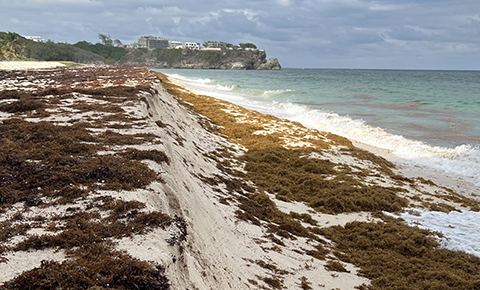University Of Southampton Study Finds Sargassum Seaweed Predicts To Spread North
Sargassum seaweed – which wreaks annual havoc on coastal communities across the tropical Atlantic – is predicted to creep further north and into Europe in the coming decades.
New research, led by the University of Southampton, has also concluded that sargassum is not the carbon sink it was initially hailed as.
Individual sargassum mats, sometimes measuring several kilometres across, have become an annual summer event since 2011, with enormous piles of the seaweed washing up on coasts across the tropical Atlantic, from the Caribbean to West Africa. It is devastating for local communities, threatening fishing, the environment, health (due to the toxic fumes it emits when rotting on beaches), and tourism.
An international team of scientists has assessed how sargassum grows and how prolific it will be in the coming decades.
They predict that, by 2050, sargassum will spread further north, even reaching southwest Europe. In addition, the ‘sargassum season’ will last for longer.
Robert Marsh, Professor of Oceanography and Climate at the University of Southampton, said: “Sargassum is very sensitive to temperature – it grows vigorously in warm tropical waters, but starts to die when the water temperature exceeds about 29 degrees Celsius. With oceans predicted to be 1.5 degrees warmer within the next 30 years, by 2050 it might be too hot for sargassum to survive summer in the tropics – however, we predict it will be more prevalent earlier in the year and will spread poleward from the tropical Atlantic belt. Carried across the Atlantic by ocean currents, we could even see it washing up on the beaches of the Canary Islands and Portugal, for example. What’s happening is a natural response to recent climate oscillations – but it is likely being accelerated by climate change.”
The team also says that sargassum has a limited capacity to absorb carbon dioxide. Professor Marsh explained: “There has been a lot of talk about sargassum being able to take carbon out of the atmosphere, but we have established that the use of sargassum as a carbon sink is not a realistic expectation.”
The team has been working with researchers from the University of York, the University of the West Indies, and the University of Ghana under a project called SARTRAC that is working to understand sargassum’s drivers and support local communities to manage it.
Professor Marsh concluded: “Sargassum currently affects countries that do not have the capacity to deal with it on their own, so there is a need for international collaboration to research and understand it, and to help manage it when it washes ashore.”

